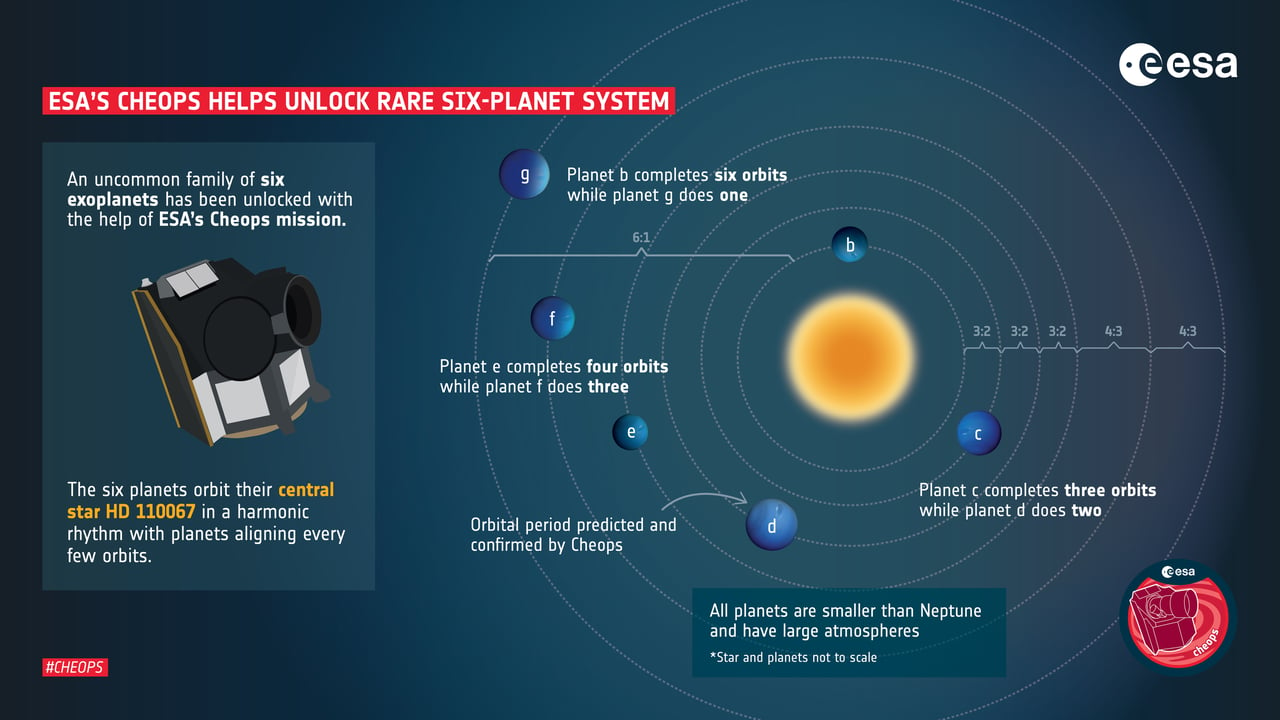(CN) — A newly discovered system of six planets, about 100 light-years away from Earth, may offer a rare chance to study how solar systems and even planets develop and evolve.
The six exoplanets orbit HD 110067, a fairly bright star in the Coma Berenices constellation, visible from Earth with a telescope. Astronomers using a NASA space telescope, the Transiting Exoplanet Survey Satellite, or TESS, which was designed to detect faraway planets passing in front of stars, first noticed several dips in HD 110067’s brightness in 2020, indicating that the star might have planets orbiting around it.
The dips in brightness were confirmed in 2022. Other researchers, using a different space telescope, the Characterising Exoplanets Satellite, or CHEOPS, also studied the system. The two satellites were able to gather enough data to put together a picture of the system: it had six planets, all larger than Earth but smaller than Neptune (or sub-Neptunes, in astronomer parlance), at least in terms of diameter, and all orbiting close to their star — the nearest planet orbits HD 110067 every nine days; the farthest every 54 days.
Finding such a large system of planets — that is, a six-planet system — all passing in front of their star, or transiting their star, from the point of view of Earth, is rare. It means their orbit lines up with the plane that astronomers are able to view it from, and it offers a rare opportunity to observe a faraway system.
“These transiting systems are worth their weight in gold,” said Hugh Osborn of the University of Bern. “Because they pass in front, you get all this precise information on the size and atmosphere of the planets. That’s why this is such an important system.”
Osborn is just one of more than 150 co-authors of a new paper, published Wednesday in the journal Nature, titled “A resonant sextuplet of sub-Neptunes transiting the bright star HD 110067.” The number of co-authors is an indication of how many people it took to make the discovery: teams from both TESS and CHEOPS working for years, including scientists from all over the world.
“These discoveries take time,” said another one of the paper’s co-authors, Rafael Luque, a postdoctoral scholar at the University of Chicago. “We need a global community to do that.”

The title of the paper hints at the other thing that makes this system so unique: the planets are in perfect resonance with each other, which is to say their orbits are in a sort of harmony. The innermost planet completes three orbits in the same time it takes the second innermost planet to complete two, which astronomers call “3:2 resonance.” The third and second innermost planets in the system also have a 3:2 resonance, as do the fourth and third. The fifth and the fourth have 4:3 resonance, as do the fifth and sixth — as the infographic above shows. The outermost planet completes one orbit for every six orbits the innermost planet completes, a 6:1 resonance.
The resonance suggests a perfect balance of gravitational forces. It also suggests that the system has been unchanged since its birth, at least 4 billion years ago.
The presence of such a system — six smallish planets, all, like Neptune, made of gas, all in harmonic resonance, unchanged since birth — presents us with what Luque called a “detective story.”
“This orbital configuration is interesting,” said Luque. “It’s very rare in nature.”
But the mystery lies not so much in why the planets are in such perfect resonance, but in why it’s such a rarity. According to scientific models, resonant solar systems should be everywhere, commonplace. But they’re not.
“We expect planets to be in this resonance, but we don’t see them,” said Luque.
The question, then, is why aren’t more systems like that? What causes systems to lose their resonance? Is it the presence of massive planets like Jupiter that throw off the equilibrium? Do meteorites crash into planets and alter their perfect balance?
The newly discovered system, said Luque, is “poised to become a controlled experiment to study how planets form and evolve.”
Now that we know where the planets are, how big they are, and how fast we’re moving, astronomers hope next to use the James Webb Space Telescope, currently in orbit around the sun and capable of infrared astronomy, to learn more about their substance: what makes up their atmospheres, their cores, and what, if anything, makes them differ from one another. The researchers have calculated the planets’ mass and density, which they believe to be relatively low, suggesting high levels of hydrogen in their atmosphere.
“It’s such a bright star, and there are so many planets transiting,” said Osborn. “We will get some of the best characterizations of these planets … . We know this is one of the very key systems that will be able to characterize multiple planets like our own.”
Follow @hillelaron
Subscribe to Closing Arguments
Sign up for new weekly newsletter Closing Arguments to get the latest about ongoing trials, major litigation and hot cases and rulings in courthouses around the U.S. and the world.
